
[ad_1]
“What the f— just happened?”
Alec Baldwin repeated the words again and again with growing urgency as the sound of the shot reverberated throughout the wooden church.
Mere seconds before, the actor had been preparing to film a scene in which he, as a grizzled 1880s Kansas outlaw, becomes involved in a shootout in a church. He was just going through the motions, giving the camera crew a chance to line up their angles.
“So,” he had said, placing his hand on the Colt .45 revolver in its holster, “I guess I’m gonna take this out, pull it, and go, ‘Bang!’”
No projectile was supposed to be in the firearm. Just a dummy round that contained no gunpowder. Baldwin was simply showing the director and the cinematographer of “Rust,” a low-budget indie western film, what he was going to do when cameras began rolling.
Instead, he shot them.
A lead bullet flew out of the weapon Baldwin had been assured was a “cold gun.” It hit cinematographer Halyna Hutchins, who stumbled back, falling into the arms of the head electrician. As she was laid to the ground, she could see the blood pouring from her chest. Behind her director Joel Souza was also down, clutching his shoulder; the bullet had gone through Hutchins’ body into his.
“What the f— was that? That burns!” Souza screamed.
Baldwin put the gun down on a church pew. He looked down in horror at his two injured colleagues, repeating his initial question like a mantra.
“Medic!” someone yelled, as various crew members huddled around Hutchins, trying to stanch the bleeding. A boom operator looked into her eyes. “Oh, that was no good,” the sound guy said.
“No,” Hutchins replied. “That was no good. That was no good at all.”
Within hours, she would be pronounced dead.
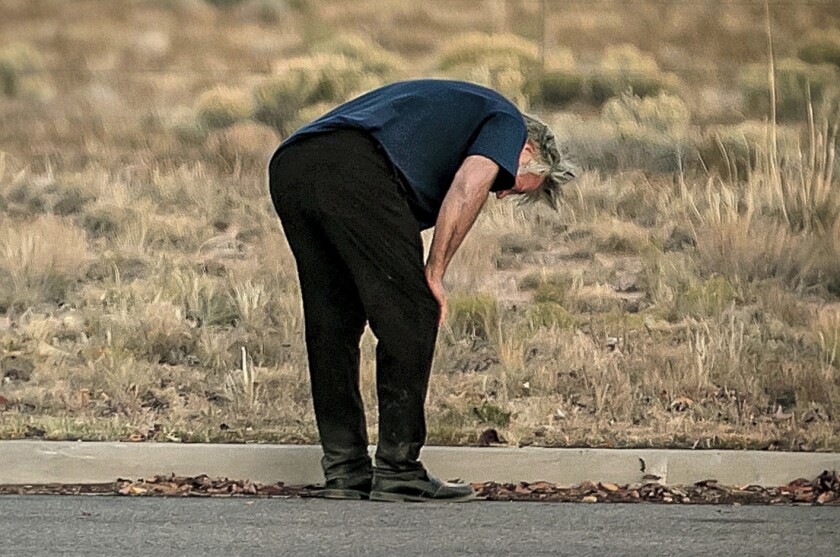
A distraught Alec Baldwin is shown after he fired a prop gun on the set of the film “Rust,” killing cinematographer Halyna Hutchins and wounding director Joel Souza.
(Jim Weber / Santa Fe New Mexican via AP)
On Oct. 21, at 1:49 p.m., Santa Fe County emergency crews were summoned to Bonanza Creek Ranch in response to a shooting that would leave the entertainment industry reeling. Hollywood loves nothing more than a good war story, a tale of the difficult conditions that a cast and crew face, the daring chance a director took to get the take, the film made on a shoestring budget that becomes an unexpected hit.
But this was no war story; this was every filmmaker’s worst nightmare. A “one-in-a-trillion episode” is how Baldwin described it to paparazzi who’d tracked him down Saturday, a week later, in a small Vermont town.
“There are incidental accidents on film sets from time to time, but nothing like this,” he told the photographers Saturday. “We were a very, very well-oiled crew shooting a film together and then this horrible event happened.”
The death of Halyna Hutchins and wounding of Souza came just a few days after Hollywood’s crews union had threatened to strike if producers didn’t take their concerns about safety seriously, and left everyone echoing the question Baldwin had cried into the chaos.
How did this happen? What had gone wrong?
Detectives are still investigating key questions, including who loaded live ammunition in the FD Pietta Colt .45 that Baldwin fired.
“I think there was some complacency on the set, and I think there are some safety issues that need to be addressed by the industry and possibly by the state of New Mexico,” Santa Fe County Sheriff Adan Mendoza said last week at a news conference.
Mendoza said that New Mexico 1st Judicial Dist. Atty. Mary Carmack-Altwies would determine whether to bring charges in the case.
A Los Angeles Times reconstruction of the events leading up to Hutchins’ death has uncovered new details about that Thursday, and the days leading up to the shooting in that wooden church about 13 miles south of Santa Fe. As has been previously reported by The Times, the inexperience of the armorer had raised concerns from the first day on set, as did conflicts between the production managers and the camera crew. A cascade of bad decisions appeared to create a set chaotic even by its low-budget status. A set in which, against all production regulations, live bullets were not only present but several had been loaded into a prop gun.
“The safety of our cast and crew is the top priority of Rust Productions and everyone associated with the company, “ Rust Movie Productions said in a statement the day after Hutchins’ death. “Though we were not made aware of any official complaints concerning weapon or prop safety on set, we will be conducting an internal review of our procedures while production is shut down.”
This report is based on interviews with 14 “Rust” crew members, including nine who were at Bonanza Creek Ranch the day Hutchins was shot, records from Santa Fe County, Santa Fe film permits and emails, text messages and internal communications from the “Rust” production. It is the most comprehensive account to date of a day that ended in tragedy, and raised concerns about the decisions made regarding safety on the set. Already, there have been calls for new laws and regulations regarding the handling of firearms on sets.
Most crew members who spoke with The Times asked to remain anonymous given the sensitivity of ongoing investigations. Scenes described in this article were based on the accounts of at least two people, unless otherwise noted. Two members of the “Rust” camera crew provided on-the-record interviews.
“It always felt like the budget was more important than crew members,” Lane Luper, the A-camera first assistant, said Saturday in an interview with The Times. “Every thing was about the schedule and the budget.”

This photo shows the Bonanza Creek Ranch one day after an accidental shooting left one crew member dead and another wounded.
(Roberto E. Rosales / Albuquerque Journal)
At 6:10 a.m. on Oct. 21, the first camera assistant operators and technicians for the film “Rust” began arriving at Bonanza Creek Ranch. It was the 12th day of the 21-day film production.
Other crew members who had parked their cars near base camp, about half a mile from the security gate, had already lined up in the catering tent. Standing in the 37-degree cold, early arrivals got their breakfast sandwiches in the dark. The crust on the bread was so hard that it broke off. But at least there was food available; it had been known to run out some days.
The camera crew skipped the meal, figuring it would be tacky to eat given their pending resignations. The camera operators went straight to the trucks near the edge of the set. After more than a week of wrangling with the film’s producers over working conditions and safety, six members of the camera team were about to walk off the set.
Bonanza Creek Ranch is a 1,000-plus-acre high desert spread near the site of an old silver mining ghost town, Bonanza City, which dried up a few years after its formation in 1880.
Since the early 1950s, the privately owned site has been a popular destination for movie production. Jimmy Stewart’s 1955 “The Man from Laramie” was filmed there. Paul Newman flirted with Katharine Ross near a ranch barn in 1969’s “Butch Cassidy and the Sundance Kid.”
Bonanza Creek Ranch was also where Hannah Gutierrez Reed, the 24-year-old armorer on “Rust,” fell in love with film. Her dad, an industry-renowned gun expert, brought his daughter, then in the fifth grade, to the location when he worked on the 2007 outlaw flick “3:10 to Yuma.”
In this part of New Mexico, yellow signs directing crew to productions have become as much a part of the landscape as the scrubby green sagebrush. Many members of the New Mexico-based crew for “Rust” live in Albuquerque, nearly 50 miles away.
Early on, camera operators — members of the IATSE Locals 600 and 480 — asked the film’s Atlanta-based production managers for hotel rooms. They didn’t want to spend an extra two hours driving to and from Albuquerque on Interstate 25, a rural four-lane highway with a 75-mph speed limit.
They had been assured hotel rooms would be provided, and during the first week of production, rooms were available to those who wanted them.
But, at the start of the second week, camera crew members were told they would no longer receive hotel rooms, according to Luper, who was the camera crew department head. Others from production were moved to the Coyote South, a former Super 8 motel, where rooms go for about $55 a night. Luper and another crew member were each given a night’s stay at another hotel during the second week of production, he said.
Late Saturday, a spokeswoman for the producers said hotel rooms were provided to camera operators and other crew members. But, she said, IATSE’s contract requires producers provide rooms only if workers spent more than 13 hours a day on the job — or if an individual crew member lived more than 60 miles away. The Albuquerque crew members lived 49 to 54 miles from set.
During the second week of production, producers consulted with the IATSE Local 600 shop steward, who wrote in an Oct. 13 email that the accommodations being offered seemed “fair,” said a person close to the production.
Luper discussed the hotel situation with Hutchins over dinner Oct. 15; she treated Luper and others to sushi. She said the issue had been resolved; Hutchins had forfeited a day’s rental of a technocrane, which enables photographers to get aerial shots, to expand the budget for lodging.
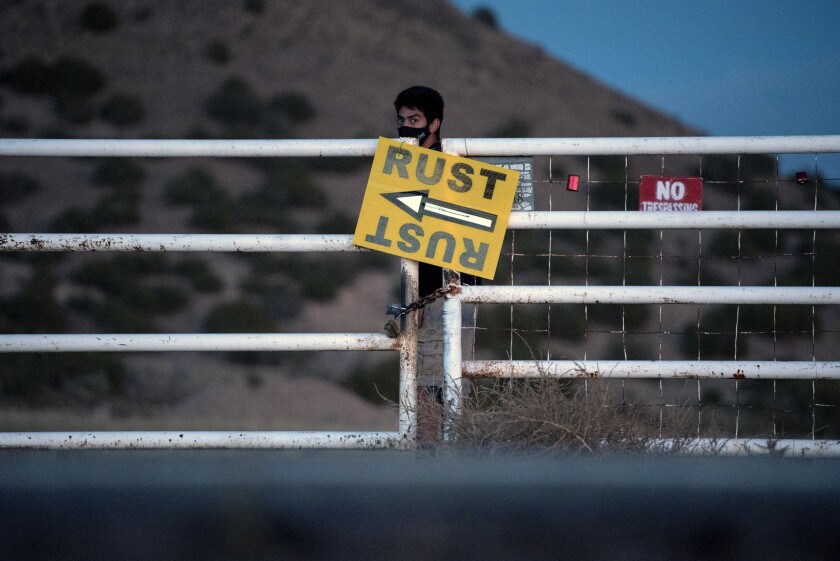
Security guards block access to the Bonanza Creek Ranch after the fatal shooting on the set of “Rust.”
(Eddie Moore / Albuquerque Journal via AP)
Other concerns plagued “Rust” from its inception. Crew members were not being paid, Luper said, and many described an overly rushed mentality on the set. Even production managers expressed concern about the capabilities of the set’s sole armorer, Gutierrez Reed.
She was responsible for all the guns on set and had worked as head armorer on only one film previously. Unit production manager Katherine “Row” Walters felt that “apparently props and armor require handholding,” according to a screenshot of an internal Oct. 8 Slack message.
Before Hutchins was killed, crew members say, there were three accidental discharges of weapons on set. Baldwin’s stunt double had accidentally fired a blank after being told that his gun was “cold.” A young woman from the props department “actually shot herself in the foot,” Luper said, adding that the round was a blank.
According to her attorneys, Gutierrez Reed “fought for training, days to maintain weapons and proper time to prepare for gunfire, but ultimately was overruled by production and her department… The whole production set became unsafe due to various factors, including lack of safety meetings.”
There had been other red flags. There was no medic on-site during pre-production; a medic’s presence is standard practice in the film industry when crew members are constructing sets. A spokesman for 3rd Shift Media, which was running the unit production, declined to comment.
“Somebody dropped a countersink bit and it stabbed me in the hand. I had to take care of it myself and I’m still healing from it,” one person said, describing an accident that occurred while constructing the hanging gallows on set.
Once filming began, Luper and other crew noted that safety bulletins were not sent out with call sheets, despite that also being standard practice in Hollywood. The producers’ spokeswoman said there were notations on the “call sheet” that referenced the guns to be used that day.

Actor Alec Baldwin fired a prop gun on the set of a western being filmed at Bonanza Creek Ranch, killing cinematographer Halyna Hutchins.
(Jae C. Hong / Associated Press)
Tensions continued to build. The Sunday before the fatal shooting, the schedule had run from noon to midnight. The film permit dictated that there be “no significant disturbance of terrain and/or vegetation” on the chaparral-covered arroyo, so the crew had to haul heavy equipment — one piece weighing 140 pounds — through a tight area where vehicles were not allowed. The afternoon sun was punishing. Gusts of wind pelted their gear with fine powdery dirt.
The camera crew stayed until 1:30 a.m. gathering their equipment, which was scattered around the site. Then they had an hour-long drive home. One camera assistant spent part of the night in his car in the parking lot, Luper said.
On Wednesday, that camera assistant, who lives in Albuquerque, requested a hotel room. The issue is a sensitive one for camera operators because they typically have to spend 30 minutes to an hour after “wrap time,” gathering and cleaning the cameras. During a separate film project in 2018, Luper said he had fallen asleep behind the wheel.
When he was told no, the tension hit a breaking point.
“We said: ‘OK, they really don’t care about us,’” Jonas Huerta, a digital utility technician, said.
In fact, within the “Rust” production office, the request for hotel rooms for crew members had been treated as a joke. So much so that someone on the production staff had ordered custom black long-sleeve T-shirts, with “Error 404: Housing Not Found” and “ABQ is an hour away” printed on them. A photo of the shirts, which someone with knowledge of the situation said arrived at the production office Thursday morning, was shared with The Times.
None of this was known to the camera crew, five of whom composed emails to Walters late Wednesday night saying they intended to resign.
Walters did not respond to repeated requests for comment.
“I have to wake up early and commute to set, my job is very physically demanding and I am beyond exhausted by the time I wrap,” Huerta wrote in his email to Walters. “I’ve found myself nodding off or having to take micro naps on the roadside just to get home safe.”
His safety concerns also extended to the weapons on set.
“I also feel anxious on set, I’ve seen firsthand our [assistant director] rush to get shots and he skips over important protocols,” Huerta wrote in his email. “ He often rushes to shoot, I’ve had more than a few occasions where I have been close to the weapons being fired with no regards to my hearing. Sometimes he rushes so quickly that props [department] hasn’t even had the chance to bring earplugs and he rolls and the actors fire anyway.”
Huerta’s email was sent Wednesday at 9:15 p.m.
“If it wasn’t for the hotel, we would have stuck it out,” he told The Times.
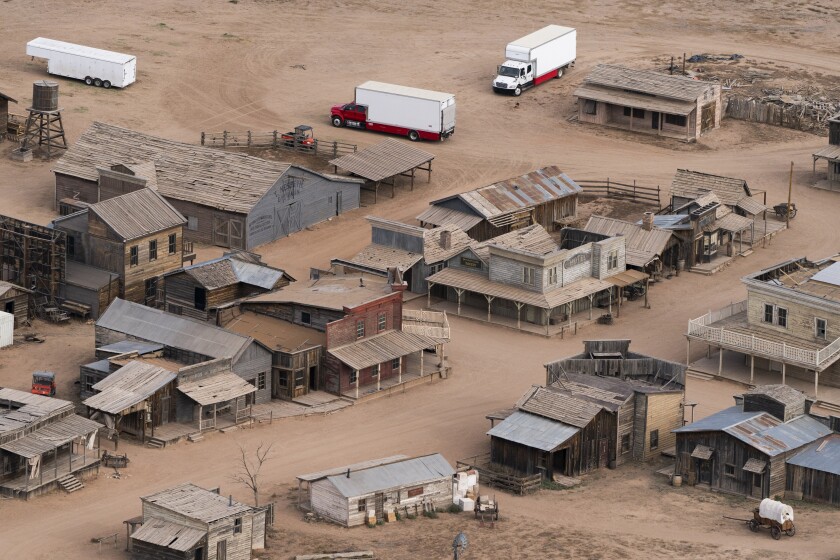
The Bonanza Creek Ranch in Santa Fe, N.M., where the western “Rust” was being filmed before a fatal shooting on set closed down production.
(Jae C. Hong / Associated Press)
At 6:30 a.m. on Thursday, having skipped their breakfast, the “Rust” camera crew hopped into the 10-ton truck that contained all the camera equipment, separating their personal equipment from the gear that had been rented by the production managers. They worked more than an hour to disassemble cameras, monitors and carts.
Hutchins, the cinematographer, and Dave Halls, the first assistant director, arrived.
Hutchins seemed confused that her camera crew was packing up. She was under the impression the hotel room issue had been resolved.
“We felt bad leaving because of Halyna,” one of the camera technicians recalled. “I was torn. We all really liked her.”
Hutchins tearfully gave Luper a big bearhug. “I feel like I’m losing my best friends,” she told him.
But they were not moving quickly enough for Gabrielle Pickle, the line producer in charge of production. She was the last to join producers who were standing in a semi-circle behind the truck, arms folded, watching the technicians pack up their gear.
Sometime around 7:50 a.m., Pickle ordered the camera crew “to work faster,” Huerta said. She pointed at Luper and said: “You need to get out this property immediately, or I will call security,” Luper recalled.
The sun was now up, and four replacement camera operators, including three non-union ones, had been trickling in. At least two looked like “they were fresh out of high school,” Luper said.
Halls ushered Hutchins away, saying they needed to go prepare for the first morning shot.
The Ukrainian-born cinematographer had forged an unlikely path to Hollywood, working as an investigative journalist on British documentary productions before turning to film. She graduated from the prestigious American Film Institute Conservatory in 2015 and was named as one of American Cinematographer’s Rising Stars four years later. At 42, she appeared on the cusp of a breakout career.
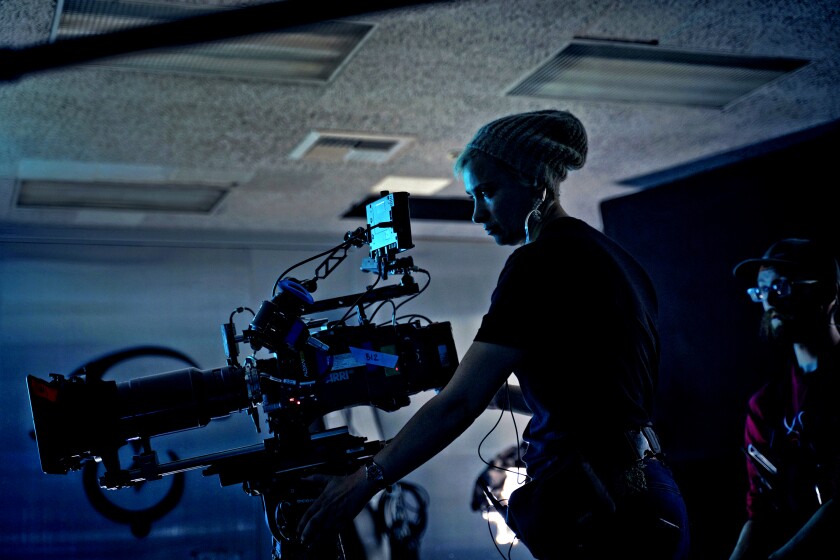
Halyna Hutchins is shown on the set of “Archenemy” on Dec. 17, 2019, in Los Angeles. Hutchins was fatally shot by Alec Baldwin Thursday on the New Mexico set of the western film “Rust.”
(Jack Caswell / Associated Press)
“Did you hear camera walked?” someone whispered to a friend as people clustered around heaters in the cold. The group’s actual exit had happened quietly, with no public scene, and some crew members didn’t realize anything had happened. The only difference some of the actors noticed was that just one camera was being used to film them.
The first setup of the day required only a single camera. But the staging was complicated, with all the main cast, save for Baldwin, riding horses together into the old western town. Setting it up took longer than expected.
Around 8 a.m., everyone gathered in the middle of the faux western town for a safety meeting.
“It was no different from any other safety meeting, and no different from a safety meeting I’d expect to have on a film like this,” an attendee recalled.
When filming began, Hutchins was positioned right in the middle of the road, her eyes glued to the monitor.
“I can’t imagine what it was like for Halyna to have to continue with what she did and keep a positive attitude,” a crew member said of that morning.
Baldwin’s call time was 7:54 a.m.
He liked to drive himself to set with his assistant in the passenger seat. The actor was a feared-but-respected presence on set, and crew members said the energy shifted whenever he arrived. Everyone tried to stay out of his eye line, lest they be a distraction.
Filming moved into the wooden church in the late morning for a handful of setups. After the last establishing shot of Baldwin was in the can, lunch was called.
Actors remained in costume in the giant catering tent, taking great care not to spill any of the Thai noodles on their frontier-style clothes as they ate. (Though the good thing about a western, one said, was that if you did get some food on your pants, you could always just rub it in and hope it passed for dirt.)
The meat of the day’s filming, including a shootout that would require pyrotechnics and smoke, was scheduled after the meal break.
After the meal, property master Sarah Zachry retrieved the guns that would be needed for the scene from a truck, where the weapons were stored inside a locked safe. The ammunition was also in the truck, but had been left unsecured on a cart during the break, according to a search warrant affidavit filed by the Santa Fe County Sheriff’s Office on Oct. 27.
Baldwin had taken pains to make his gun work look realistic. A few days earlier, he’d gone into the church to walk through what it would be like to use the weapon in the scene. The live rounds he fired contained blanks, but still made enough noise that crew members were startled.
“Alec was pretty concerned about safety on set,” said another camera technician.
“He wanted to know where I would be standing when he drew his gun,” this person said. “I told him I was going to be standing in a different place, and he said, ‘Good.’”
That Thursday, the crew began preparing for the scene before Baldwin had returned from his lunch break. Gutierrez Reed entered the church with the firearms, performing a safety check with the Colt .45 in front of Halls. He thought he saw three rounds inside the gun, but he did not check them before taking the weapon in his hand.
He told investigators that “he should have checked all of them, but didn’t, and couldn’t recall if she spun the drum,” according to the affidavit.
The armorer left the church.
No stand-in performers were on site, so the first assistant director ran through Baldwin’s blocking himself, pulling the gun three times. Russell, a B-Cam operator, watched the action unfold from a monitor on his dolly. Hutchins stood over his shoulder, flanked by Souza.
Because of the walkout, the team was working with fewer monitors than usual. The 10-inch screen in video village wasn’t great quality, so the filmmakers opted to review the optics on the dolly’s monitor, which was seven inches but had higher resolution.
During the scene, Baldwin’s character was supposed to fast-draw his weapon and shoot at a rival. Halls had not pulled the gun’s trigger during the run-throughs he performed.
But when Baldwin entered the church to do a quick rehearsal, he apparently did.
The bullet barely missed Russell before hitting the DP and the director. The trio was about two feet from the muzzle of the weapon.
A dummy round, which contains no gunpowder and doesn’t fire, would look nearly identical to a bullet when the camera peered down the barrel of the revolver Baldwin was holding, with none of the lethal capabilities.
If the rounds had been checked as they went into the gun, Halls would have seen that at least one lacked the small hole or indent that visually differentiates dummies from bullets. He would have also noticed that it didn’t make the signature rattling that proves there’s only a BB — and no gunpowder — in the dummy round.
Shock rippled through the church. Sixteen crew members were stationed among the church pews. No one was wearing any protective gear — the noise-canceling headphones, safety goggles or furniture moving blankets often offered for scenes involving guns.
It was just supposed to be a dummy round.
Someone screamed and Hutchins fell to the ground instantly, as did Souza, though it was not immediately obvious that he had been hit.
“I was looking right at her, I could see an exit wound that immediately started pouring blood and that’s when [people screamed] ‘She’s shot!’ and everything went crazy,” a crew member said.
“Let’s clear everyone who doesn’t need to be here out of here,” Halls urged the crew.
Mamie Mitchell, the film’s script supervisor, ran outside and called 911 from her cellphone. It was 1:46.
“Bonanza Creek Ranch. Two people accidentally shot on a movie set by a prop gun. We need help immediately,” Mitchell said.
Less than 13 minutes after she hung up, the first Santa Fe County Fire Department emergency responders arrived on scene.
Crew members were shrieking. Sobbing. Shell-shocked. Production assistants, some in their early twenties, were busy guarding the church in an attempt to keep unnecessary parties out. Other young staffers were told to clear the road of crew vehicles, electrical wires and errant church pews so that the ambulances could drive directly up to the church when they arrived.
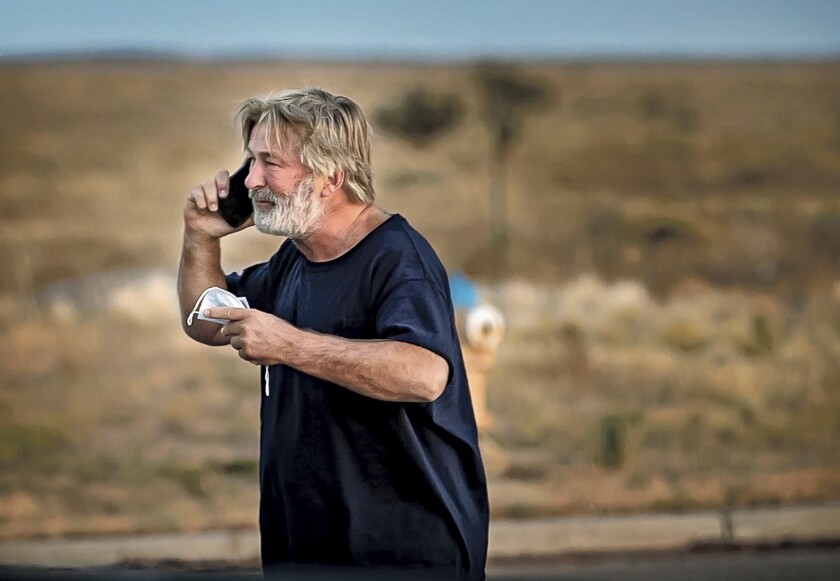
Alec Baldwin speaks on the phone after he was questioned about a fatal shooting on the set of the film “Rust.”
(Jim Weber / Associated Press)
Down at base camp, a handful of actors were preparing for their scenes that afternoon. Through the window of his trailer, one performer heard a crew member receive an urgent-sounding message over the walkie-talkie: “There’s been an incident. We called 911.”
Still, the actor wasn’t especially concerned. There was typically an overabundance of caution on movie sets. A production assistant asked the talent to remain in their trailers. “Don’t take any photos. Don’t text your friends. Let’s keep this contained,” the staffer advised.
But after about 10 minutes, the actors started getting restless. Some walked to the doors of their trailers to confer with one another. “Two people got shot? How? What the f— ?”
Back in Santa Fe, “Rust” production staff working out of a peach-colored office park plodded forward with payroll and travel logistics, not yet aware that anything was wrong.
On Slack, an internal messaging system used in the office, a production secretary pinged her bosses at 2:03 to say she had a quote ready from a vendor, but still needed to know about sending a truck to get the equipment. That same minute, the fire battalion chief radioed dispatchers to request a medical transport helicopter.
Two ambulances arrived around 2:08 p.m. After passing through the rusting white ranch gates onto unpaved dirt and gravel roads, the emergency vehicles all slowed to about 20 miles per hour.
Even when the helicopter began hovering over the ranch at 2:15. p.m. — just as Souza’s ambulance prepared to depart for St. Vincent Regional Medical Center in Santa Fe — the gravity of the situation was difficult to absorb.
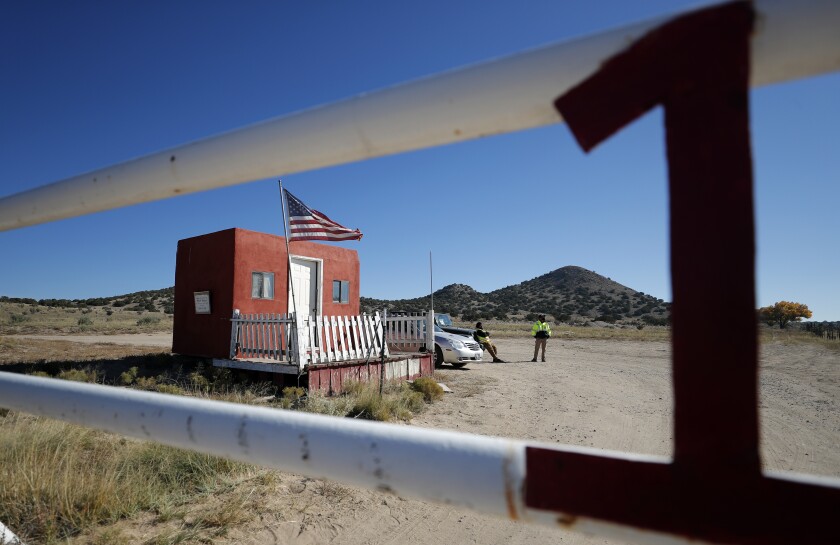
Private security stand at the entrance of the Bonanza Creek Ranch in Santa Fe, N.M. Authorities are investigating the fatal shooting of cinematographer Halyna Hutchins and the wounding of director Joel Souza on the set of the western “Rust.”
(Andres Leighton / Associated Press)
A crew member who’d left to run an errand was stopped at the front gate as she tried to drive back onto the ranch.
“Nobody’s allowed to go up there except the police officers and ambulances,” someone from the transportation department told her. They had to be joking, she thought.
“No,” they said. “Someone has been shot.”
As the first responders worked, police officers requested that all of the crew members who had witnessed the shooting sit for an interview.
“Starting crime scene logs,” was noted in the dispatch record at 2:35 p.m. Everyone else was sent home, and detectives tied off the church area with yellow caution tape.
The aircraft remained on the ground until 2:50 p.m. It seemed like a long time to the actor. How bad could the injury really be if the helicopter stayed on the ground for over half an hour?
Hutchins would ultimately be pronounced dead at the University of New Mexico Hospital in Albuquerque, to which she had been airlifted.
Back at Bonanza Creek Ranch, Baldwin and about a dozen others sat on the back of a 5-ton truck, awaiting their interviews with police who were inside a faux saloon.
Down at base camp, people were spooked but attempting to remain calm. Trained to comfort with food, a craft services assistant began to pass out homemade trail mix.
Around 3:30, Baldwin returned to base camp. He had changed out of his costume and was wearing his street clothes. “I’ve never been handed a live weapon — ever,” he told his peers, who circled around him. No one there tried to console him because no one there knew just how bad the accident had been.
By late afternoon, news that someone had been shot on a Santa Fe film set was ricocheting through New Mexico’s tight-knit film community. People scrambled to text family and friends on other nearby sets, trying to confirm that they were safe.
Russell, the B-Cam operator who’d nearly been hit by the bullet, drove down to UMN Hospital to try to check on Hutchins.
Luper, the A-camera first assistant who’d quit that morning, picked him up. They were together at Luper’s house when they learned of Hutchins’ death from the news.
At roughly 5:30 p.m., production asked the remaining crew members who had driven themselves to set to form a long line with their cars and exit the ranch en masse.
A few local newspaper reporters had gathered on the street, and driving out altogether would make it more difficult for the media to reach anyone.
International media would descend on Santa Fe in the days that followed, with television crews perpetually stationed outside the sheriff’s office and the entrance to the ranch.
Production crew gathered for a private memorial for Hutchins on Friday night in Santa Fe. At much larger vigils in Albuquerque on Saturday and Los Angeles on Sunday, remembrances conjoined with a broader reckoning around safety on sets.
Producers officially announced their decision “to wrap the set at least until the investigations are complete” in an email to crew members on Sunday night.
They were quietly trying to wrap production as the investigation unfolded. There was travel to book, rental equipment to return and a seemingly endless tally of things to be scanned, shipped or donated.
To-do lists were written and shared in Slack, where Pickle, the line producer, chimed in: “Any remaining alcohol donated to row and gabby!” Someone responded with a thumbs up emoji.
In another message, the line producer’s assistant tasked a PA with donating the office lamps to Goodwill.
“No name or production,” she wrote, “just [d]rop it and run.”
[ad_2]
Source link